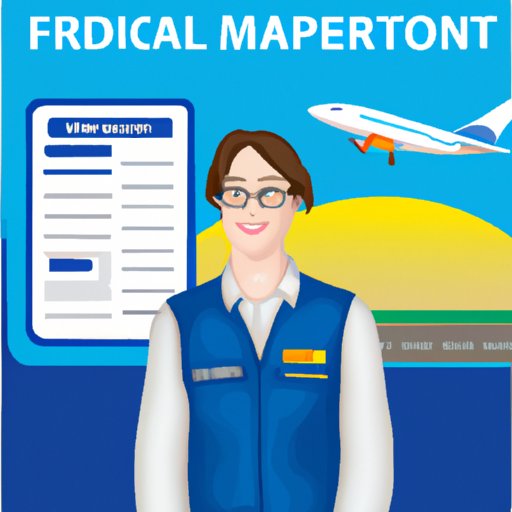Introduction
Becoming an airline pilot is an expensive endeavor. The cost of becoming an airline pilot includes tuition fees, licensing fees, training costs, medical examination fees, aircraft rental fees, flight simulator fees, instructional fees, and exam fees. This article will explore the various costs associated with becoming an airline pilot and provide an overview of the financial commitment of pursuing a career in commercial flying.

Outlining the Costs of Attaining an Airline Pilot License
The first step in becoming an airline pilot is obtaining a private pilot’s license. According to the Aircraft Owners and Pilots Association (AOPA), the cost of obtaining a private pilot’s license can range from $7,000 to $15,000 depending on the type of aircraft used for training and the number of hours logged. This cost includes tuition fees, licensing fees, and training costs.
In addition, aspiring pilots must pay for the FAA Medical Examination and any associated fees. According to the AOPA, the cost of the exam ranges from $100 to $300, depending on the complexity of the exam.

Breaking Down the Expenses of Becoming an Airline Pilot
Once an aspiring pilot has obtained their private pilot’s license, they can begin working towards a commercial pilot’s license. To do so, they must complete additional training and pass several exams. This process can be costly and time-consuming. According to the International Civil Aviation Organization (ICAO), the cost of this training can range from $20,000 to $50,000 depending on the type of aircraft used for training, the number of hours logged, and the location of the training facility.
In addition to the cost of training, aspiring pilots must also pay for aircraft rental fees, flight simulator fees, instructional fees, and exam fees. Aircraft rental fees can range from $100 to $500 per hour depending on the type of aircraft used for training. Flight simulator fees typically range from $50 to $200 per hour. Instructional fees vary by instructor and can range from $50 to $150 per hour. Finally, exam fees vary by region and can range from $50 to $200.
Examining the Financial Investment of a Career in Commercial Flying
In addition to the costs associated with obtaining a professional pilot’s license, aspiring pilots must also consider the financial investment of a career in commercial flying. Salaries and benefits vary by airline and can range from $50,000 to over $200,000 annually depending on the size and scope of the airline. In addition, there are potential job opportunities at regional airlines, cargo carriers, and corporate flight departments.
Other financial considerations include insurance, retirement plans, and continuing education. Insurance rates vary by region and can range from $200 to $400 per year. Retirement plans vary by employer and may include 401(k) plans, pension plans, and other retirement options. Finally, aspiring pilots must budget for continuing education courses and seminars to stay current with industry regulations and best practices.
The Price Tag of Earning a Professional Pilot’s License
In addition to the costs associated with obtaining a professional pilot’s license, aspiring pilots must also consider the cost of additional qualifications such as instrument ratings, multi-engine ratings, and type ratings. Instrument ratings allow a pilot to fly in low visibility conditions and can cost up to $10,000 depending on the aircraft used for training. Multi-engine ratings allow a pilot to fly aircraft with multiple engines and can cost up to $20,000 depending on the aircraft used for training. Type ratings allow a pilot to fly specific types of aircraft and can cost up to $30,000 depending on the aircraft used for training.
What is the Cost to Become an Airline Pilot?
The total cost of becoming an airline pilot can range from $40,000 to $100,000 depending on the type of aircraft used for training, the number of hours logged, the cost of additional qualifications, and other factors. In addition to these expenses, aspiring pilots must also budget for travel expenses, lodging, food, and other miscellaneous costs that may arise during training.

Exploring the Financial Commitment of Pursuing a Career as an Airline Pilot
Although becoming an airline pilot requires a significant financial investment, there are potential long-term savings associated with pursuing a career in this field. Salaries and benefits are competitive and job opportunities are plentiful. Additionally, many airlines offer retirement plans, health insurance, and other benefits that can help offset the cost of obtaining a professional pilot’s license.
Calculating the Total Cost of Becoming an Airline Pilot
The cost of becoming an airline pilot varies depending on the individual’s circumstances. It is important for aspiring pilots to carefully calculate the total cost of obtaining a professional pilot’s license and compare it with the cost of other career paths. By taking the time to research and compare the cost of becoming an airline pilot, individuals can make an informed decision about whether or not this career path is right for them.
Conclusion
Becoming an airline pilot requires a significant financial investment. The cost of obtaining a private pilot’s license, completing additional training, and obtaining additional qualifications can range from $40,000 to $100,000 depending on the individual’s circumstances. Although this cost may seem high, there are potential long-term savings associated with pursuing a career in commercial flying. Aspiring pilots should carefully consider the costs and potential benefits of becoming an airline pilot before making a final decision.
(Note: Is this article not meeting your expectations? Do you have knowledge or insights to share? Unlock new opportunities and expand your reach by joining our authors team. Click Registration to join us and share your expertise with our readers.)
